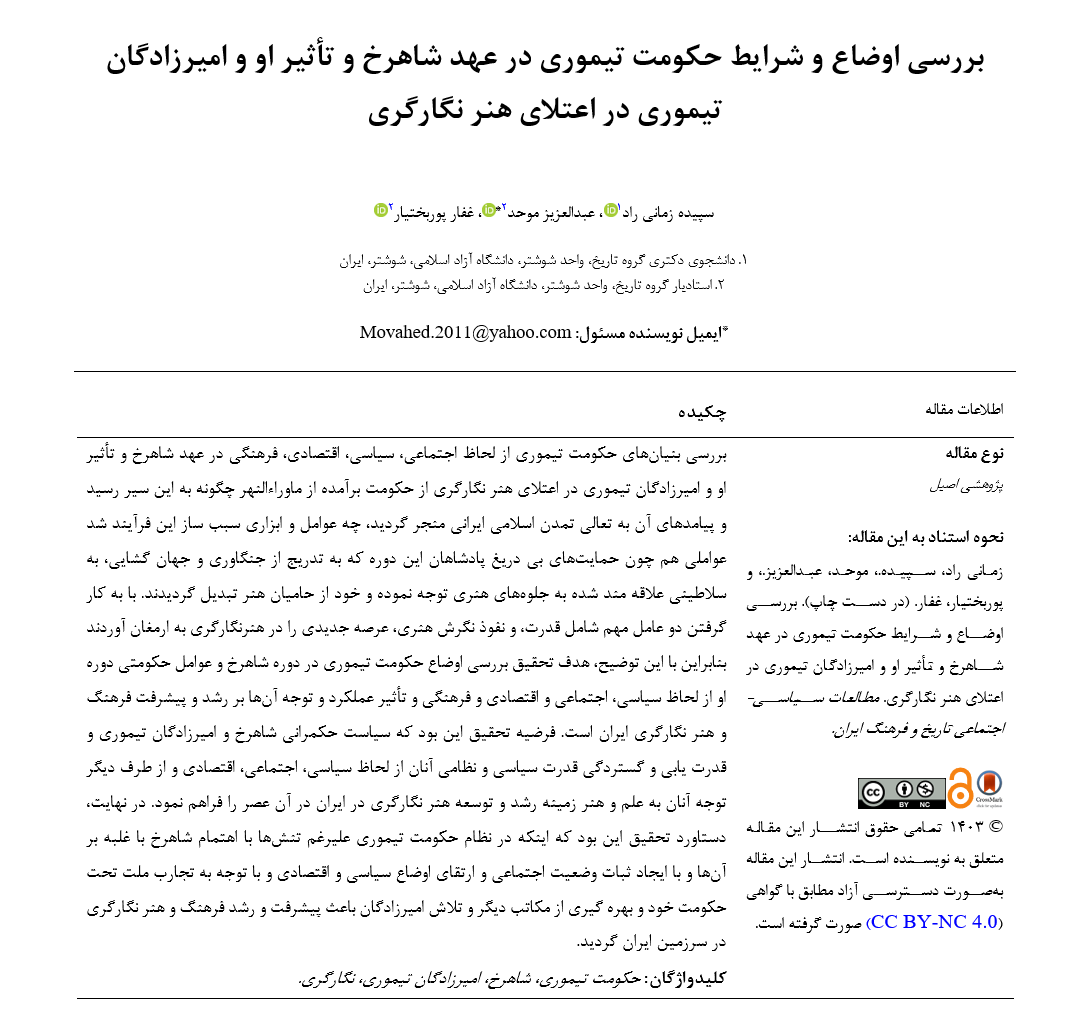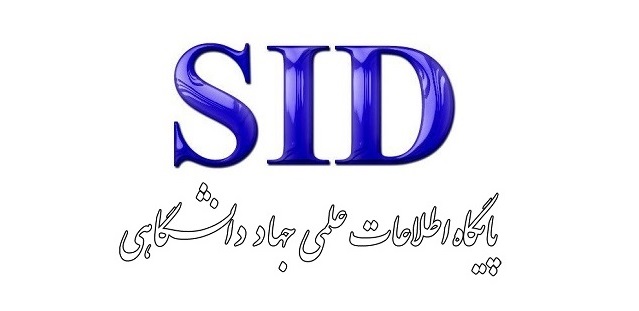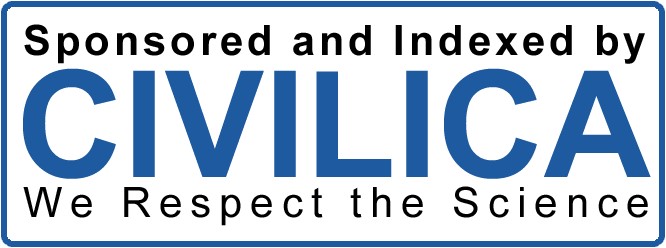An Examination of the Political Conditions of the Timurid Dynasty during the Reign of Shahrukh and the Influence of Shahrukh and Timurid Princes on the Flourishment of Persian Painting
Keywords:
Timurid government, Shahrukh, Timurid Princes, Persian paintingAbstract
The examination of the foundations of the Timurid Dynasty in terms of its social, political, economic, and cultural aspects during the reign of Shahrukh, as well as the influence of Shahrukh and the Timurid princes on the flourishment of Persian painting, traces how this government, which originated from Transoxiana, reached this development and how its outcomes contributed to the elevation of Islamic-Iranian civilization. What factors and means enabled this process? Among them were the unwavering support of the kings of this period, who gradually shifted from warfare and conquest to become monarchs interested in the artistic manifestations, ultimately transforming into patrons of the arts. By utilizing two key elements—power and the influence of artistic vision—they introduced a new era in the art of Persian painting. Therefore, with this explanation, the goal of this research is to examine the political, social, economic, and cultural conditions of the Timurid government during the reign of Shahrukh, and the influence of their policies and focus on the growth and advancement of Persian painting culture and art. The research hypothesis suggests that the governance policy of Shahrukh and the Timurid princes, alongside their political and military strength and expansion, in addition to their attention to knowledge and art, laid the foundation for the growth and development of Persian painting in that era. Ultimately, the research concludes that despite the tensions within the Timurid government, through Shahrukh's efforts to overcome them, the establishment of social stability, and the enhancement of political and economic conditions—along with drawing from the experiences of the nation under their rule, adopting other schools of thought, and the efforts of the Timurid princes—led to the advancement and growth of Persian painting culture and art in Iran.
Downloads
References
Abd al-Razzaq Samarqandi, K. a.-D., & Nava'i, A. a.-H. (1975). Matla' al-Sa'dayn wa Majma' al-Bahrayn.
Amir Ali Shir, N. i., & Herati, M. A. (1984). Majalis al-Nafa'is (Book of Anecdotes). Manouchehri Publications.
Amirkhani, G. (2004). The Role of Books in the Cultural Relations of the Timurids. Ketab Quarterly, 4.
Asfizari, M. i. a.-D. M. (1959). Rawdat al-Jannat Fi Awsaf Madinat Herat. University of Tehran.
Azhand, Y. (2008). The Herat School of Painting. Academy of Arts of the Islamic Republic of Iran.
Barthold, V. V. (1987). Turkestan Nameh.
Clavijo, & Rajabnia, M. (1958). Clavijo's Travelogue. Institute for Translation and Publishing of Books.
Fasih Khafi, A. J., & Farrokh, M. (1960). Majmal Fasihi.
Ghafari Qazvini, Q. A. (1964). Tarikh-e Jahangosha.
Ghiathi, A. b. F., & Hamedani, T. N. (1975). Ghiathi History.
Hafez Abru, H. (2001). Zubdat al-Tawarikh. Ney Publishing and Ministry of Culture and Islamic Guidance.
Hekmat, A. A. (2001). Jami: Research on the Life, Works, and Writings of Nooruddin Abdul Rahman Jami.
Heravi, N. M. (2002). Book Decoration in Islamic Civilization. Islamic Research Foundation of Astan Quds Razavi. https://www.aqr.ir/en/research
Ibn Arabshah, A. b. M., & Nejati, M. A. (1977). The Astonishing Life of Timur. Elm and Farhang Publications.
Jafari, J. f. i. M. i. H. H., Khoei, A. Z., & Kashani, N. M. (2014). Jafari History. Morakh Publishing.
Jami, N. A. R. (1962). Complete Divan - With a comprehensive introduction to the literary, philosophical, and political history of the 9th century (2nd ed.). Pirouz Publications.
Kavousi, V. (2009). The Foundations of Art Development During the Timurid Era. Ayeneh Khial, 12.
Khaleghi Motlagh, J. (1985). Introduction and Evaluation of Some Manuscripts of the Shahnameh. Iran Nameh, 3(11).
Khwandamir, G. a.-D. b. H. a.-D. (1938). Dastur al-Wozara. Iqbal Publishing.
Khwandamir, G. a.-D. b. H. a.-D. (1974). Habib al-Siyar Fi Akhbar Afrad al-Bashar. Khayyam.
Korkian, M., Seiker, & Marzban, P. (2009). The Gardens of Imagination: 7 Centuries of Iranian Miniatures. Farzanfar Publications. https://www.farzanfarpub.ir
Lane-Poole, S., & Iqbal, A. (1984). The Classes of Islamic Sultans. https://www.islamicsultanspub.com
Malfajani, M. (2022, February 15). The Political-Social History of the Timurids. https://www.ibna.ir/en/doc/naghli/316122
Mir Khwand, M. Y. V. E., & Mohaddes, M. H. (2000). Khuld-e Barin (The History of the Timurids and Turkmans). Institute for the Publication of Written Heritage. https://www.writtenheritage.ir
Mu'in al-Din, N., & Aubin, J. (1957). Muntakhab al-Tawarikh-e Mu'ini. https://www.tawarikhmuini.com
Pakbaz, R. (2004). Iranian Painting from the Past to the Present (3rd ed.). Zarrin and Simin Publishing.
Price, C., & Rajabnia, M. (2001). History of Islamic Art. Amir Kabir Publications.
Qazvini, Y. i. A. L., & Tehrani, S. J. (1984). Lab al-Tawarikh. Gooya Foundation Publications.
Safa, Z. (1997). The History of Literature in Iran. Ibn Sina Publications.
Samarqandi, A. a.-R. (1986). Matla' al-Sa'dayn wa Majma' al-Bahrayn.
Samarqandi, D. (1958). Tazkirat al-Shu'ara. Asatir Publications.
Samarqandi, K. a.-D. A. a.-R. (2004). Matla' al-Sa'dayn wa Majma' al-Bahrayn. Institute for Humanities and Cultural Studies.
Sherato, B., Ettinghausen, R., & Azhand, Y. (1997). The Art of the Samanids and Ghaznavids. Moli Publications.
Taj al-Salmani, T. (1955). Shams al-Hasan (Historical Book). Wiesbaden.
Yarshater, E. (1955). Persian Poetry During the Reign of Shahrukh (First Half of the 9th Century): The Beginning of the Decline in Persian Poetry. https://www.persianpoetry.com/decline
Yazdi, S. a.-D., & Bernyakov, A. V. (1972). Zafarnameh.

Downloads
Published
Submitted
Revised
Accepted
Issue
Section
License
Copyright (c) 2024 سپیده زمانی راد (نویسنده); عبدالعزیز موحد (نویسنده مسئول); غفار پوربختیار (نویسنده)

This work is licensed under a Creative Commons Attribution-NonCommercial 4.0 International License.







